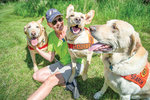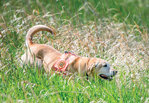Cloudy, 57° F
It was a training day. So when Kris Brock arrived at Beck Lake Park with her three excited companions, she took a human rib bone out of her truck and headed for the high grass.
The bone was not …
This item is available in full to subscribers.
The Powell Tribune has expanded its online content. To continue reading, you will need to either log in to your subscriber account, or purchase a subscription.
If you are a current print subscriber, you can set up a free web account by clicking here.
If you already have a web account, but need to reset it, you can do so by clicking here.
If you would like to purchase a subscription click here.
Please log in to continue |
|




It was a training day. So when Kris Brock arrived at Beck Lake Park with her three excited companions, she took a human rib bone out of her truck and headed for the high grass.
The bone was not a chew toy, nor was Brock afraid of losing it: Her dogs are highly trained to locate humans or their remains.
The threesome are your typical, loving, sweet-faced yellow Labs. Mitchell, graying at 8 years old, can melt your heart with one glance; Brock calls his gray accents his “sugar face.” Six-year-old Charlie is a gentle giant, towering over his pack and weighing in at 90 pounds. Colt, the shortest and youngest, is ornery and athletic. Brock calls him Colter when he’s in trouble — and the 2-year-old knows the nickname well. The trio has not only been trained to find people — dead or alive — but has also gone through extensive social training.
Colt still needs a little work on his aim when greeting new friends, but is well on his way to becoming an asset for the Park County Search and Rescue team.
Brock joined Search and Rescue in 2002 with her first dog, Tate, still in training. It wasn’t until 2004 that she finally had a certified pup. Tate has since passed away, but now Mitchell, Charlie and Colt are following in his footsteps. All three of Brock’s lovable Labs are certified as live and cadaver dogs. Mitchell is also certified for water searches, with Charlie and Colt still in training.
The night before the recent training session in Cody, Brock returned from a 1,300-mile road trip for specialized training.
Brock responds to all calls, not just those requiring the services of her Labs, but the team is also busy. The canines once responded to 46 calls in a single year — 29 of them for cadavers. It’s not an easy job for humans or their service animals.
“They don’t feel the human emotion like we do unless they feed off our sadness,” Brock said. “We work really hard for it to be a big party for them because for them it’s a game of hide and seek.”
The dogs work for the praise or a toy as their rewards, she said.
“They’ll do it all day and be thrilled to death to find [their target],” Brock said. “Live people are a lot of fun because they’re super excited to be found and it’s a big party. But when it’s a cadaver, dogs don’t feel that sadness like we do as long as we keep it upbeat.”
Staying positive is easier said than done.
“It tries on you. Some are harder than others,” she said. “But when I have a find with a dog — it almost sounds bad — it’s upbeat because the dogs have done their job and we can see they’ve succeeded. It’s usually a couple days later when you really get sad.”
The Search and Rescue team, realizing the need for emotional assistance, started a support group and emphasize critical incident stress management. “If we have a trying call, we’re there for each other,” she said.
Finding a deceased child is hard, Brock said. “Those are the hard ones to drive away from.”
Powell’s Chris Walker, of Triple A Dog Training, was voted in as a member of the Search and Rescue team in January. He’s already been on missions. His first was a suicide at Buffalo Bill Dam earlier this year, in which a local teenager died.
“If there’s anything I’ve come away with from the tragedy, it’s how professional and knowledgeable Park County’s team is and how they are there for you to help [with emotional trauma] after the job is done,” Walker said.
Walker has decided his personal mission is to use his talents in training canines to train his own pup, Chipper, for the Search and Rescue team. The effort is something new to the experienced trainer, who works with pets for home, field and as service animals. “There’s so many more variables,” Walker said of search and rescue efforts. “Searches can happen in town, in buildings, in the woods, on water or in the badlands.”
It will take more than a year before Chipper is ready for a certification test, if it ever happens. Walker said you can spend thousands of hours and thousands of dollars to train a dog for a specific purpose, but not all dogs are able to be certified. He is amazed by the dedication Brock has shown to train her Labs. “There’s a reason why this is not for everyone,” he said. “Kris is so knowledgeable and has the drive and desire to do it.”
Working together has helped form a friendship between the two dog enthusiasts.
Park County Search and Rescue has about 30 members and all but the coordinator are volunteers.
Many are trained for all seasons and every possible scenario. But Brock’s and Walker’s focus is on rescue dogs, spending thousands of hours in training and traveling to rescue sites each year.
“It’s a way I can give back to the community,” Walker said.
They foot the bill for almost every expense, but at times get help from donations made by those in the community. “It’s all on us unless we get donations,” Brock said.
Working search and rescue dogs is a labor of love. Though it’s hard at times, at the end of the job, there is always the comfort of a pup willing to give unconditional love.